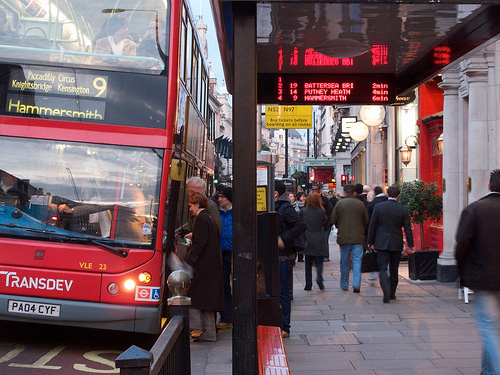Jay Walder’s Well-Placed Priorities: Doing More With New York City Buses
“In London, you
carry nearly twice as many people in the bus system as you do on the
Underground.” In New York, the opposite is true. “We must close the gap and
make more of the bus system.”
— Jay Walder, MTA chairman, as quoted in the New York Times
 Improvements like real-time arrival displays led bus ridership to grow significantly during Jay Walder’s tenure at Transport for London. Photo: King Huang Chung/Flickr.
Improvements like real-time arrival displays led bus ridership to grow significantly during Jay Walder’s tenure at Transport for London. Photo: King Huang Chung/Flickr.In the transit landscape inherited by Jay Walder, the MTA’s new chairman, buses are a rare
potential bright spot amidst an otherwise dismal world of funding shortages, fare hikes,
labor unrest, stalled mega-projects, and feckless
politicians. Judging from recent
remarks, Walder seems to recognize this and is poised to make better bus
service a major focus.
While it may seem obvious that
the chair of the MTA should devote considerable energy to buses, this is rarely the case. The head of the MTA is typically consumed by planning, funding, and managing
mega-projects and the capital plan. Historically, the MTA has been
heavily oriented toward subways and commuter rail. On the average weekday, the agency’s
subways carry 5.2 million trips and its buses 2.4 million.
But these are not
normal times at the MTA. Walder has one year to make a big impression. After that
he will almost certainly have a new boss as governor, who will have two options: fire Walder or rehire
him. Bus improvements can be done relatively quickly and cheaply, and by
reducing delays can actually save money while resulting in better service and
higher ridership.
Buses are also attractive to
Walder because the mayor and DOT are already aggressively pushing bus corridor
improvements. DOT and the MTA have launched a successful Select Bus Service route on Fordham
Road in the Bronx, with new routes planned and funded for First and Second Avenues in 2010. The mayor is a
good friend to have. He controls streets, parking enforcement and seats on the
MTA board.
But Select Bus Service only helps a handful of the MTA’s
250 bus routes. Also needed are system-wide
improvements. Walder has identified three of these as priorities.
First is a
swipe-free or "contactless" MetroCard like London’s Oyster Card, which is
waved over a sensor on buses and subways. This would reduce boarding times.
Second is GPS-based, real-time information for riders waiting at bus
stops. This would reduce uncertainty over travel times and help reduce
bunching. The MTA has struggled with GPS location for years, while similar technology has been adopted by transit systems around the world and in New York City taxis.
Third, but most
emphasized by Walder, is improved enforcement of bus stops and lanes, especially
with automated enforcement cameras. Enforcement cameras are in widespread use
in London. But here, they will require approval by the state legislature. Given
that the legislature is struggling with profound internal dysfunction, massive
state budget deficits, and a collapsing MTA capital plan, it will likely be a tough lift for bus lane cameras to win approval. It took DOT decades of effort to win its
relatively small number of red light cameras.
Regardless of the exact
improvements he undertakes, there is a powerful logic steering Jay Walder
toward bus improvements. And that is good news for long-suffering bus riders.





